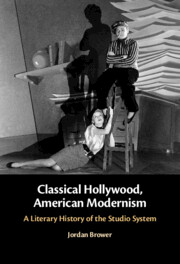Book contents
- Classical Hollywood, American Modernism
- Classical Hollywood, American Modernism
- Copyright page
- Dedication
- Contents
- Figures
- Acknowledgments
- Introduction
- Chapter 1 Paramount Pictures and Transmedial Possibility
- Chapter 2 MGM Modernism
- Chapter 3 The Motion Picture Industry’s Coming of Age
- Chapter 4 Global Hollywood
- Chapter 5 The Scenes of an Ending
- Chapter 6 Conclusion
- Notes
- Index
Chapter 5 - The Scenes of an Ending
Adaptation, Originality, and the New Authorship of Hollywood Pictures
Published online by Cambridge University Press: 04 January 2024
- Classical Hollywood, American Modernism
- Classical Hollywood, American Modernism
- Copyright page
- Dedication
- Contents
- Figures
- Acknowledgments
- Introduction
- Chapter 1 Paramount Pictures and Transmedial Possibility
- Chapter 2 MGM Modernism
- Chapter 3 The Motion Picture Industry’s Coming of Age
- Chapter 4 Global Hollywood
- Chapter 5 The Scenes of an Ending
- Chapter 6 Conclusion
- Notes
- Index
Summary
Beginning in the immediate postwar and coincident with the Paramount antitrust decree, writers of both fiction and screenplays began to insist on the ownership of the works they produced. While flesh-and-blood authors conceived of themselves as corporate bundles of properties, the studios began to behave more like artists, investigating the possibilities of movies geared to specialized audiences. The literariness of these new pictures should be understood as the expression of a new conception of authorship pervading the industry. Many movies now considered noir, including In a Lonely Place (1950) and Sunset Boulevard (1950), manifest the industry’s shifting attitudes toward source material, original screenplays, and, ultimately, the idea of the Hollywood movie as a kind of literary expression. This chapter concludes with an analysis of All About Eve (1950). In its narrative of accommodation and uneasy coherence in the face of a common threat, Eve, unlike In a Lonely Place and Sunset Boulevard, strikes a balance between the conflicting intentions of its director (the self-consciously literary Joseph Mankiewicz) and its studio (Twentieth Century-Fox), giving legible shape to both.
Keywords
- Type
- Chapter
- Information
- Classical Hollywood, American ModernismA Literary History of the Studio System, pp. 143 - 177Publisher: Cambridge University PressPrint publication year: 2024

